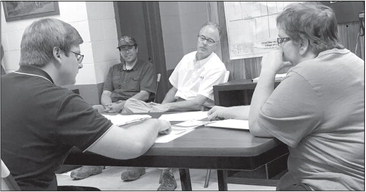MSA offers 2nd opinion on Curtiss sewer plant


Curtiss officials got their first look at a second opinion for a multi-million dollar sewer plant upgrade last week Tuesday.
MSA Professional Services, which had originally proposed an overhaul costing over $20 million, came back with alternatives ranging from $4.7 million to $6.1 million.
In a memo to village officials, the company explained that it had adjusted its plans based on “newly provided data” from the village about how much waste Abbyland Foods plans on discharging to the village’s treatment facilities.
The initial $20 million plan assumed that the company would increase its high-strength waste output anywhere from 10 to 50 percent. The new proposals consider that Abbyland will either keep its output the same or reduce its flow.
“Several significant changes have occurred since the planning process began, including changes in Abbyland’s hauling high-strength wastewater to Abbotsford, resulting in reduced loadings at the plant, and developments in water quality trading related to meeting low level phosphorus limits,” MSA wrote in a memo to village officials.
MSA has already written a draft facility plan that calls for a two-phase, $20 million biofilm reactor and tertiary filter to remove phosphorus and ammonia from the village’s wastewater. This would replace the current five-lagoon system operated by the village.
However, since Abbyland would be responsible for paying the lion’s share of the treatment plant upgrade, the company is considering treating all of its own industrial waste instead.
Abbyland already handles most of its ownindustrialwasteproducedinCurtiss by hauling it to the company’s treatment plant in Abbotsford. That includes all of the industrial waste from its distribution center and truck wash, plus about half the waste coming from its pork plant.
Upgrades to the village’s lagoon treatment system are needed for several reasons, including the need to meet stricter limits set by the DNR on ammonia and phosphorus discharges. The bottoms of the lagoons are also too close to the groundwater underneath, meaning that all five of them may need to be raised. That process itself could cost $5.6 million, according to MSA estimates.
MSA’s newest plans include two treatment alternatives involving additional facilities being added on to the lagoon system. One is called a moveable bed biofilm reactor (MBBR), which would cost $6.7 million, and the other is a proprietary system called a Submerged Attached Growth Reactor (SAGR), at a cost of $4.7 million.
Both alternatives would include construction of a chemical storage facility, at a cost of $500,000, that would feed phosphorus-removing chemicals into the treatment system. The village is also exploring other means of removing phosphorus, such as adding specialized pellets to the treatment process.
MSA engineer Mike Voss said either the MBBR or the SAGR unit is needed to address ammonia removal. However, if the village wants to continue to use the treatment ponds, it has to prove that they are not contaminating nearby groundwater.
“The price for the MBBR and SAGR assumes that the DNR would let us continue to use the ponds, but you’d probably have to put in the cost of adding test wells,” Voss said.
Trustee John Unruh heavily scrutinized MSA’s newest proposal, asking several pointed questions about the need for such expensive equipment to remove ammonia. He presented data showing that ammonia effluent levels dropped at the plant by 66 percent after Abbyland starting hauling away a lot of its own waste in 2017 and the village stopped using a certain herbicide on the edge of the ponds in 2018.
MSA’s proposal also includes an “alternative path” that would rely on the existing lagoons to remove ammonia and a chemical feed system to deal with phosphorus limits. “However, this alternative path includes significant risks for the Village of Curtiss and may result in non-compliance and enforcement actions by the DNR...,” MSA wrote. “The DNR takes into account several factors such as number of violations, potential harm to the environment, and whether the permittee willfully violated the terms of its permit.”
Unruh has made it clear that he was not happy with MSA’s initial $20 million proposal, and he remains skeptical about whether the firm will fully work with village officials to develop the most cost-effective project. The board is also getting “second opinions” from two other engineering firms, CBS Squared and Cooper Engineering.
“If our engineers won’t listen to us, we’ll find other engineers,” he said.
